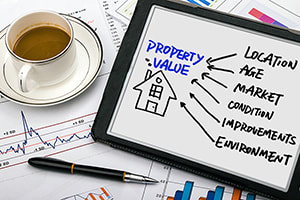 Click There are many reasons why some people prefer to rent an apartment rather than purchase a home. Some jobs require considerable travel and occasional job-location transfers. Career-oriented professionals in their twenties find it easier and more convenient to pack up an apartment when it's necessary to move. For the majority of people, however, purchasing a home makes practical and financial sense. Home ownership in the United States is at almost 64 percent and on the rise. It is within the majority of Americans' reach and can be just as affordable as renting. Personal Investment A rental unit can cost as much, or more, per month than the mortgage payment on a home, but without the financial benefits. Home ownership is an investment. Each payment increases your equity, and each improvement you make increases the home's value. Owning a home is also a tax advantage. Real-estate property taxes, insurance, and mortgage interest are all deductible expenses. When you pay rent, you don't receive any of these financial benefits. Growing Money (Equity) The amount of your down payment determines the size of your mortgage payment. The money you put down on your home is instant equity. When you buy a home, the majority of your early payments goes toward the loan interest, and only a small amount goes toward the principal. After a period of time, the majority of your payment will go toward the principal. That means the equity in your home is growing faster, and as the paid principal amount grows so does your investment. When you sell your home, you will make money on your investment. Home prices continue to rise, and any remodeling you do also adds additional resale value. Freedom to Make Changes When you own your home, you are free to paint a door, rip out a wall, add a porch, or plant a garden. You don't need anyone's permission. (Restrictions may apply if you live in a development managed by a homeowner's association). A homeowner has freedom to make changes to their house, but a renter has to ask permission to repaint a wall. Payment Stability With a fixed-rate mortgage, the homeowner will not experience any change in payment for the length of their mortgage. Knowing exactly what to expect each month places the homeowner in a stable environment. Renters, however, must continually sign leases and deal with increases in their payments. Their only option is to look for another apartment with a lower rent. to edit.
0 Comments
 A Comparative Market Analysis (CMA) is routinely done for sellers to determine a listing price for their home based on current market conditions. Knowing how a CMA is created will help you understand why it's so valuable in finding a home's market value. Comparables (Comps) Are Selected The listing agent locates three or more recently sold homes comparable to the one ready to be listed. The best comps will: ✓ Be as near as possible to the home ready to be listed (same neighborhood, if possible). ✓ Have the same features or as near as possible (bedrooms, baths, garage, etc.). ✓ Sold as recently as possible, because the older the sale, the less reliable the CMA. Sold Prices Are Adjusted The sold price is adjusted to account for differences in features or characteristics. If the comp has one less bedroom, the value of a bedroom is appraised or estimated and added to the sold price. If the comp has one extra bedroom, the value would be deducted from the sold price. This brings the total sold price to an estimated amount based on if the comp had identical characteristics with the home in question. Average Sold Price per Square Foot Once the adjusted sold prices are calculated, they are averaged to find the average sold price per square foot. This number is multiplied by the square footage of the home ready to be listed to establish a tentative listing price. There are several variables that make this an exercise in estimation, not a nailed-down price. It is as accurate as possible based on the comps selected, but there is some flexibility in the final pricing.  Low interest rates make it tempting to refinance, but refinancing usually comes with some upfront, out-of-pocket costs. It’s not a race to simply have a rock-bottom rate, but sometimes it makes sense to refinance. Here are four reasons to take advantage of low rates: 1. Reduce your monthly payment. On a 30-year, fixed-rate mortgage, a 1% difference in interest rates works out to about a $60 monthly difference per $100,000 owed. Keep this in mind: if you have only 25 years left on your current loan, you’ll be extending the loan period by five years by refinancing for another 30 years, and will probably pay as much or more in total interest over the life of the loan. 2. Reduce your interest by paying off your home faster. If you currently have a 30-year mortgage, refinancing to a 15-year loan can mean paying less in total interest over the life of the loan. Even if you’ve paid the mortgage for five years, you’ll shave off 10 years by switching to a 15-year loan. These 15-year loans usually come with lower interest rates. The more the interest rate has dropped from when you first bought your home, the less your monthly payment will increase. 3. Switch from an adjustable rate to a fixed rate. Typically, an adjustable-rate mortgage has a lower initial rate than a fixed-rate loan, and after a period of time, the rate changes. When rates are low, and your adjustable-rate mortgage is about to shift to a higher rate, refinancing to a low fixed-rate mortgage can ensure that you’ll lock in an affordable rate for the life of the loan. 4. Cash in on equity to pay off higher-interest debt. If your home is worth $300,000, and you owe $200,000, you have $100,000 in equity. Cash-out refinancing lets you access some of that money to use for home improvements or to pay off higher-interest debt. Most lenders will refinance up to 80% of your home’s value for a cash-out refinance, which means you could get a new loan of $240,000. Using $200,000 to pay off your old loan, you’d have $40,000 remaining—minus any closing costs or loan fees. Here’s the bottom line. Low interest rates make it tempting to refinance, but refinancing isn’t free. To make it worth your while, assess your goals first and then do the math to see if a new mortgage fits those goals. |
AuthorA variety of pertinent real estate topics and tips from various authors and contributors. Archives
December 2024
Categorieshow much home can i afford?*
|


